#their starting point was the botanical illustrations of
Note
id love to see your collection/list! my tarot niche is cat themed decks but i love seeing what otber people are drawn to :)
My Collection of Divination Decks
You're so sweet! You got it! I wish this post hadn’t taken so long. When it was halfway done I decided to take the pictures myself instead and got overwhelmed so I've done it a bit at a time. Anyways you guys remember that I'm always happy to help you find beginner decks that work for you or decks that fit certain ideas or themes! Rather if that's more inclusivity, certain vibes, the deck being based on animals, plants, etc. Don't be afraid to reach out!
Without further delay, the decks...
The Classic Rider Waite

This was my first deck as I'm sure it was for a lot of people. I heard a lot of people talking about it and knew a lot of other decks were based on it so I got it. I'm glad it was my first deck because it helped familiarize me with all the Rider Waite based decks yet to come in my practice and it's just a sort of neutral starting point. I could also see the appeal in getting a more themed deck which is why I offer to help beginners find one that fits their needs. The good deck is the deck you'll pick up and use!
The Linestrider Tarot

This was my first deck that's well... not just the plain old Rider Waite. I was 14 or 15 when I got it so it probably wouldn't be my first pick now, aesthetic wise, but I have a huge soft spot for it. It's always felt like I was in tune with this deck and I love little details like that The Fool has no face and the two of cups are cats! Like isn't that just the cutest? Also it wasn't that expensive and came with a solid box and a thick guidebook, which is always a welcome bonus in my opinion.
The Hedgewitch Botanical Oracle
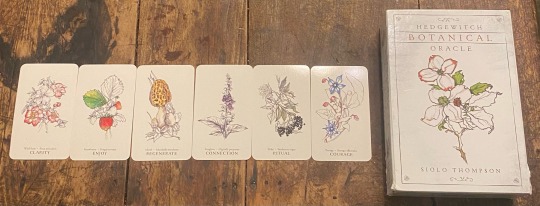
Ah, my first oracle deck, as you might have guessed. It was also made by the same artist that made the Linestrider tarot, which you may also have guessed. I'm pretty sure I got them at the same time because I adored this art style so much. I like the way this deck is laid out. There's detailed illustrations of plants, and y'all know I love a deck with plants, as well as the name of the plant and the main theme of the card written on it. I need to use this deck more! Let me know if you guys have tips for doing oracle readings or using oracle decks more.
The Star Spinner Tarot

I was interested in this deck for its inclusivity. it's also a hopeless romantic deck in my opinion. It has a fairytale sort of art style and you can choose between four different The Lovers cards, two of which are distinctly gay. Also the two of cups are pink mermaids, what else could you possibly want?
The Avatar Arcana
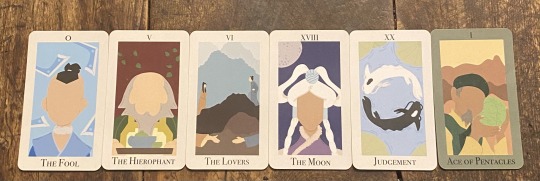
This deck is based on avatar the last airbender if you couldn't tell or aren't familiar with that series. It's a fandom deck. I was such a feen for it when I found it online. I waited patiently for it for ages. I feel like the selections for what characters go with what cards, especially on the major arcana, are a little on the nose and show that this is more of a novelty deck. But hey, it's a deck themed around a show, I knew what I signed up for, y'know? Anyways I'm very happy to have it!
The Illustrated Herbiary Oracle

This deck is going here because I wanted to show all the decks in my collection. It was a gift and even though I don't wanna be ungrateful, I'm hard to buy gifts for, and picky about my decks. I usually like decks based on plants (and have several in my wishlist) but this one just isn't my favorite if I'm being honest. I think it's the borders. Either way it's in my collection, which makes it worth note, and who knows! Maybe someone else will love it or just generally be inspired to get a plant based deck.
The Dream Interpretation Oracle

The cards are unfortunately bent on this deck so there was a slight glare on a few cards, but even if they’re hadn’t been I feel like the cards here or any picture just couldn’t do this deck’s vibes justice. I got it at witchfest (which I'm so excited for this year, that's a whole different happy ramble) and I feel like it really captures the strangeness of my dreams. There are whole cards for things like shoes, or shouting. Shuffling the cards is a weird time indeed.
The Antique Anatomy Tarot
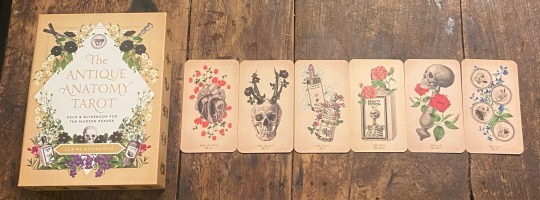
I feel like this deck is quite popular and for good reason. It’s exactly what it sounds like. It has vintage vibes, it has skulls, it has flowers, these are some of my favorite things to draw so of course they are some of my favorite artistic themes in a deck. I have multiple decks on my wishlist that are just based on skeletons or plants. I love how this deck combines the two. I also like how on the elixirs, the labels on the bottles relate to the card's meaning. Additionally the jumbling of body parts in a lot of the coins suit, particularly the four of coins shown is also an aspect I like. It just looks neat to me.
The Fyodor Pavlov Tarot

This is by far my favorite deck so this section will be so so long and I'm not sorry! This is double special interest material. I'm t4t and deserve to gush about my representation damn it.
So I’ve been trying to stick to 6 cards max with maybe the back of the card's pattern or box shown for these pictures, however this deck is my favorite and just too good to contain with such restrictions. I worked so hard to get this deck. I saw The Lovers card online and fell in love. The card's artwork is t4t and I'm SO t4t and so in love with just The Lovers card as an art piece in general. Anyways after I found just that card somewhere online I said a prayer that a full deck by the artist existed, and went on the hunt for it. I found it. I originally found the kickstarter, which had stopped, and after some digging found out the artist had moved the sales to Etsy. The artist was packaging small batches all on his own. I tried to get it twice off Etsy and both times it sold out immediately. The deck has now had an official release and is a lot easier to get. I preordered that newer version and waited months and months for my beloved and it was by FAR so worth it.
I love that this deck is Rider Waite based but inclusive to various experiences. This includes the minority representation, but also details like how the queen of cups is pregnant. Maybe I don't look at a lot of decks but I feel like I don't see that very often and I think details like that are cool. As you'd probably expect, the artist is queer and trans and I love that and supporting them and that kind of artwork. He's also a tattoo artist and I feel like that shows in his work. I love artwork with ink, but I'm biased, because my artwork is usually ink based. Also I already put too many cards in the picture so they're not there but shoutout to Strength and The Hermit in this deck for being women.
Basically I love this deck more than I can put into words!
The Tarot of Pagan Cats

The newest addition to my collection! This is a mini deck that makes me want about ten million more cat themed decks. When I decided to take the pictures myself for this post I added some other cards. Originally I was just gonna have The Tower though. I feel like it tells you everything you need to know. This deck is adorable and charming. The Fool makes me laugh as well as The Tower and Strength. The Lovers, as well as the two and ten of cups are just precious. The design for Death is perfect. Fuzzy, and somehow still comes across as stern. I want more cat decks!!!
(Also side note down here real quick for that one person, someone asked if I could go over how the decks personalities differ from each other but I found I was very bad at putting that into words especially in this post so that will have to be something I talk about elsewhere if I do!)
This post was about gushing and the vibes but if you guys want beginner deck recommendations, help finding a deck that fits your niche, or for me to show off my wishlist in a similar style, just ask!
Thanks for letting me gush and reading the whole post. I had such a fun time making it ❤️
#witchblr#witchcraft#tarot#tarot decks#tarot deck collection#witch collection#divination deck collection#deck collection#divination collection#divination#cartomancy#inclusive tarot decks#tarot cards#tarot witch#tarotblr#witches#witch#justsomecatsinatrenchcoat#trans tarot deck#trans witch#queer witch#avatar tarot deck#fandom tarot deck#rider waite
131 notes
·
View notes
Note
Imagine the perfect day; what does that look like? What do you smell, what would you eat, where would you be?
Ideally it'd be mid to late spring, before it's too hot, but when it's still just cold enough you only need a cardigan and maybe a lap blanket.
I'd wake up early like usual, but I wouldn't hate it or complain about it- and for once I wouldn't be groggy. My billion pills I have to take would go down lovely without a fight- or any nasty aftertastes for once.
I'd make myself a full service Tea for breakfast (proper tea pot, proper warmer, proper tea cup, proper Loose Leaf Tea and an infuser- and some homemade Rice Pudding made with Mango and Coconut Milk), and take it out to the garden to enjoy it in the sunshine while watching the birds. I'd do whatever work there was to do on the garden after.
At some point I'd take a walk around either the Botanical Garden or the Lake with my Husband- or if my body's gone to shit again, I'd ideally have a Wheelchair finally, and he'd push me. Or maybe I'd start another Folk Art piece instead (which reminds me that I need to start on the new one I have planned).
Around dinner time we'd dance together in the kitchen while cooking something fun and new- probably out of one of my many Vintage Cookbooks we love playing with; The Illustrated Encyclopedia of American Cooking (1968) has never let me down. I've been wanting to make the Cranberry Chicken out of it again, lately. It was so delicious the last time I made it.
Mostly, though, I'd spend the day cuddling and goofing off with my Husband, playing with the Cats and the Dog, and enjoying the sunshine; windows open to let in the air, and a candle lit (I literally have a stash of 25 candles right now- and that doesn't include the box of empties. Don't ask me to pick a scent; currently I'm burning a Woodwick 'Amethyst and Amber').
6 notes
·
View notes
Text

✨️☀️Flower Language in Azul's Broomquet☀️✨️
Hello hello! I'm relatively new to the broomquets in general, but I am a very big fan of flower language and the such. Since Azul is my favorite character, I'd thought I'd start with him once his card dropped, and I'm so glad I did! His broomquet is ripe with meaningful flowers.
Obligatory 'I am not a botanics expert and I'm doing this just for fun'. I do have a little bit of knowledge identifying flowers but I may get a couple wrong.
For ease, I'll be listing the flowers in a bullet-point list manner, with the meanings i find most fitting highlighted in purple.
Folliage:
Lemongrass: fresh starts, energy, man's love
Eucalyptus: strength, protection, abundance
• Rosemary: rememberance, love, lust, loyalty
The folliage were the easiest to identify since they have such distinct flowering patterns and I grew up using all of them. Lemongrass may be a bit tricky, though, since it looks like lily grass— but I'd thought Azul fits more aromatic herbs— also its possible meanings didn't quite work.
Flowers:
Small disclaimer for these fuckers; some of these flowers very closely resemble other completely different species in the illustration and it was difficult to pin-point some of the back flowers. The ones that I'm unsure of are marked with a * And after the meaning I list the alternatives I found.
Lisianthus (lavender): Charisma, Charm, Gratitude, Confidence
Carnation (lavender): Compassion, Capriciousness, Calmness, Introspection, Creativity
Lavender: Purity, Silence, Devotion, Grace, serenity
Bell heather: Good luck, Admiration, Protection
Aster (lavender): Wisdom, Royalty
Clematis (light purple)*: Quick wit, Intelligence, Ambition, Hope, Cheerfulness, Rest, Optimism, Truth (Alternatives: Iris, hydrangea)
Pompon chrysthanthemum (green)*: Hope, Rest, Longevity, Good health (Alternatives: Hellebore, Waxflower-white)
Rhododendron*: Hard work and success, Dangerous beauty, Wealth (Alternatives: Cattleya, Lily, Petunia)
These are my closest guesses so far. I've seen some people choose lavender roses instead of lisianthus, but I think the petal pattern matches the lisianthus better. There may be some other flowers hidden in the ssr banner, but since I don't have the card yet, I wouldn't be able to tell (please come home king).
By far the hardest to identify was the mums, and I am still very doubtful about them either way as the flowers drawn in look more like buds.
If anyone else wants to contribute, feel free to!
40 notes
·
View notes
Text
kamen rider geats: they’re for you
fandom: kamen rider geats
ship: keiwa/ace
au: tattoo artist and florist au
notes: VERY rough
Ace watered sunflowers, a focused frown on his face. When he finished he watered other flowers. He put the watering can and the spray bottle behind the counter. He took out the pruning shears from his apron pocket. It was a Wednesday and the early afternoon sun came through the windows.
Ace put down a plastice sheet on the counter then took out flowers. He carefully trimmed the stems, dropping them onto the trash can. He put the flowers in different piles as he worked. He heard the door open. Ace looked up. 'Welcome,' he greeted, he set a flower aside, 'hello, Keiwa-san.'
'Hello, Ace-kun!' Keiwa greeted cheerfully.
'What can I do for you?' Keiwa shook his head, a notebook in his hand. Ace looked at Keiwa's neck curiously. He was wearing one of his loose t-shirts and on the side of his neck was geometric tattoo. That was new.
'Just looking around,' Keiwa answered, 'is it ok if I stay for a little bit.'
Ace thought about it. 'You can but you might have to pay,' he said amused.
Keiwa blinked. He looked at Ace surprised. 'Ace-kun!'
'Just kidding,' Ace said. Keiwa looked relieved. 'What are you here for?'
Keiwa went to to bucket of flowers. He opened his notebook. 'Studying. I wanna draw flowers!' He started sketching.
Ace rolled up the flowers. 'I might have something that'll help.' Keiwa glanced up from the notebook. 'Give me a moment.' Keiwa nodded.
Ace put away the flowers, putting some in the stands while putting the rest in the back. He put those in the coolers. He wiped his hands then went looking for something. He was looking for a set of books. He found it by his bags. He went back to the counter. 'Here.'
Keiwa went to him. 'What are they?'
'They're botanical illustrations.' Keiwa frowned in confusion. 'They're drawings of plants,' Ace explained.
Keiwa's frown shifted to surprise. 'Really?' he asked amazed. Ace smiled. Keiwa flipped one open. 'But I'll destroy them!'
'I know,' Ace said. Neon and Michinaga complained about Keiwa being clumsy a lot. 'It's alright, I'll just buy another copy.'
Keiwa looked at the stack for a moment then up at Ace. 'Thank you, Ace-kun.'
'You don't have to thank me,' Ace tilted his head slightly, 'is that a new tattoo?'
Keiwa blinked. His hand came up to touch the side of his neck. His face brightened. 'It is! Just got it yesterday.' He leaned foward, turning his head away. Ace lifted his hand. His fingertips touched Keiwa's skin. Keiwa shivered. 'I can give you one if you ever want one.'
Ace moved his hand away. 'I don't know which one I'll get and where to put it.'
Keiwa looked at him. 'I'll help you decide! And when you do, I'll do it.'
Ace smiled. 'I'll remember that.' Keiwa looked at books. He started flipping through them and Ace went back to work. He swept up the stems then went back to the counter.
Keiwa spent a few hours in the flower shop as Ace greeted customers. Sometimes Keiwa glanced at Ace. Ace met his eyes twice. Keiwa quickly turned away. Ace looked at him confused, what was that about?
Keiwa took his phone out of his pocket. He checked the time. He looked around. 'What are you looking for?'
'A flower!' Keiwa's eyes landed on the orange lilies. He took one then took a daisy and a white orchid. He laid them down on the counter.
'You don't have to buy anything,' Ace said, 'what color of paper and ribbon would you like?'
'I know but I have to. Black paper and red ribbon, please. They remind me of you.' Ace looked at Keiwa surprised as he wrapped the flowers. Keiwa looked at him curious. What? A moment later, it came to Keiwa. His eyes widened. 'I mean-!'
'It's alright,' Ace said. He said the price. Keiwa yanked his wallet out of his pocket. He held out the money expression embarrassed. Ace gave him the receipt and Keiwa put in his wallet. Ace put the flowers in front of him.
'No!' Keiwa said.
'They're your flowers,' Ace pointed out.
'I know but...' Keiwa thought about it. He picked up the flowers then held it out. Ace looked at it confused. 'They're for you,' Keiwa mumbled.
Ace took them. He smiled. 'Thank you.' Keiwa nodded stiffly. He picked up the books from the counter then stepped back. 'See you tomorrow.'
'See you tomorrow,' Ace answered. Keiwa's expression was of relief. He walked out of the flower shop, Ace waving at him through the window.
4 notes
·
View notes
Photo

REVIEW
Buttercream Botanicals for Beginners by Leslie Vigil
Simple techniques for creating stuffing flowers, botanicals, and more
Having taken several months of cake decorating classes while in the USA unable to return home due to hostilities near our home, I wanted to see what this book might offer and how it would compare with what I learned decades ago. Little did I realize when I requested to read and review it that it was written by a master in buttercream frosting that creates art on cakes that are lifelike and museum quality.
The provides recipes for basic buttercream frosting and basic cakes, discusses essential supplies, how to get started, four fundamental techniques, how to prep the cake canvas and how to add final touches to uplift the final product.
What I liked:
* Recipes were concise and used natural easily found ingredients
* Photos to illustrate steps and desired results
* New to me use of slip-joint pliers to adjust piping tips to personal specifications
* Gel colorants – have used liquid and paste but have not tried gel and they seem to be more concentrated
* The variety of new colors to create when making decorative buttercream frosting – this section reminded me of the color charts I created for watercolor painting and how various shades can be achieved
* The ‘adding color accents’ section was new to me and intriguing – how to add an accent color to the piping bag to give two-tones with each squeeze of the piping bag
* Notes and tips to make it all easier when a new concept is introduced
* The variety of new ideas that I have never seen or tried: succulents, stitchery, using buttercream piles to create elevation on a cake, color combinations
* The four fundamental techniques: Blossom, Rose, Mum, Leaf (what I learned was basic and may have included these long ago BUT did not put them into application as illustrated in this book…makes me want to get my tips out and try some decorating again)
* The photos of final product with step-by-step instructions to create numerous end products for decorating a cake with tips to use and
* The variety…so much of it…and how it reminded me again of watercolor and trying to create certain flowers in pain on paper…now want to create the same flowers on cakes and cupcakes
It would be a treat to attend one of this author’s classes at some point in time. After doing a bit of online searching I found that there are courses offered online by the author and those would be a treat to attend at some point in the future.
Thank you to NetGalley and Quarto-Quary Publiishing for the ARC – This is my honest review.
5 Stars
BLURB
Discover how to turn any cake or cupcake into a showstopping work of art with realistic, modern flowers and plants made from a rainbow of colors of buttercream frosting.
Flowers are the most popular cake embellishments, but making them look natural and professional can be tricky. Professional cake artist Leslie Vigil has been teaching beginning bakers and decorators for years how to create authentic roses, daisies, peonies, dahlias, chrysanthemums, marigolds, tulips, ranunculus, plus succulents, cactus, and greenery out of buttercream, giving them the skills and confidence to embellish cakes and cupcakes like a pro.
In Buttercream Botanicals, she’ll do the same for you, starting with her tried-and-true signature cake and buttercream recipes and demonstrating expert methods for adding color, blending shades, and working with the most effective tools. Leslie will also show how four core piping techniques form the base for creating a huge variety of botanicals. Decorated cakes and cupcakes are the perfect centerpiece for any seasonal holiday or celebration, including birthdays, weddings, anniversaries, showers, and graduations.
Working with buttercream is easy and accessible. Troubleshooting tips and tricks throughout the book will make piping shapes and designs a breeze.
In addition to thorough step-by-step tutorials for creating beautiful blossoms and more, the book also includes:
Instructions for making edible flower pots for a complete eye-popping display
Pro tips for designing appealing compositions on cakes and cupcakes such as wreaths and bouquets
Faux tapestry techniques using simple piping techniques
Ways to create various icing textures and effects, such as stucco
Grab a piping bag and make your cake dreams a reality with Buttercream Botanicals.
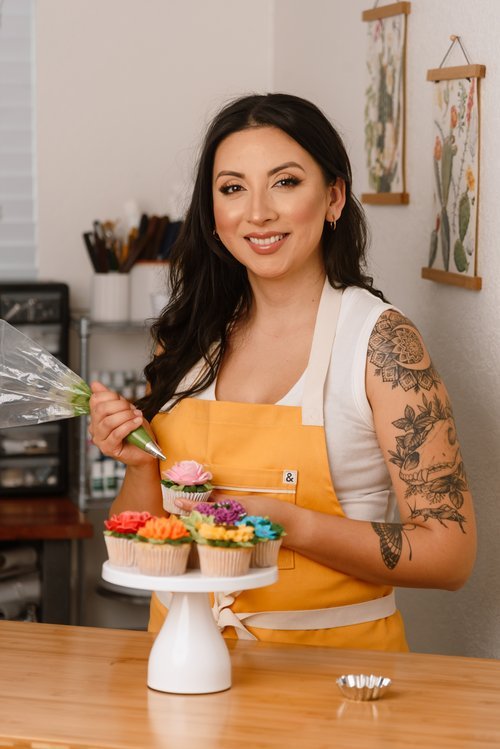
ABOUT THE AUTHOR
L e s l i e V i g i l
Cake Artist. Author. Instructor. Flour Child. Buttercream Enthusiast.
Featured in Better Homes and Gardens, Colossal, Popsugar, Insider, Food and Wine, BuzzFeed and more.
As a self-proclaimed “flour child” and “buttercream enthusiast”, Leslie Vigil creates edible art inspired by nature, plant culture, floral design and textiles. From realistic floral bouquets to potted cacti and succulents in a terra cotta vessel, Leslie uses buttercream as her medium for her cake art. As an instructor, she not only shows you what she can do with buttercream, but shows you what you can do with buttercream. Using her Four Foundational buttercream techniques and recipe for buttercream, Leslie Vigil teaches you how to create your own myriad of beautiful buttercream botanicals and more.
Website https://leslievigil.com/
Instagram https://www.instagram.com/_leslie_vigil_/
Twitter
#Leslie Vigil#Buttercream Frosting#Hobbies#Cake Decorating#Baking#Art#craft#NetGalley#Quarto Publishing-Quary Books
2 notes
·
View notes
Text
Week 2.2: Photography, Type, and Alphabet
Photography
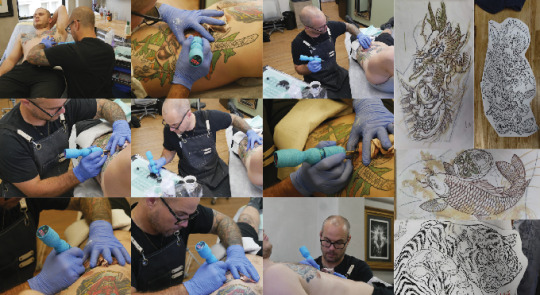

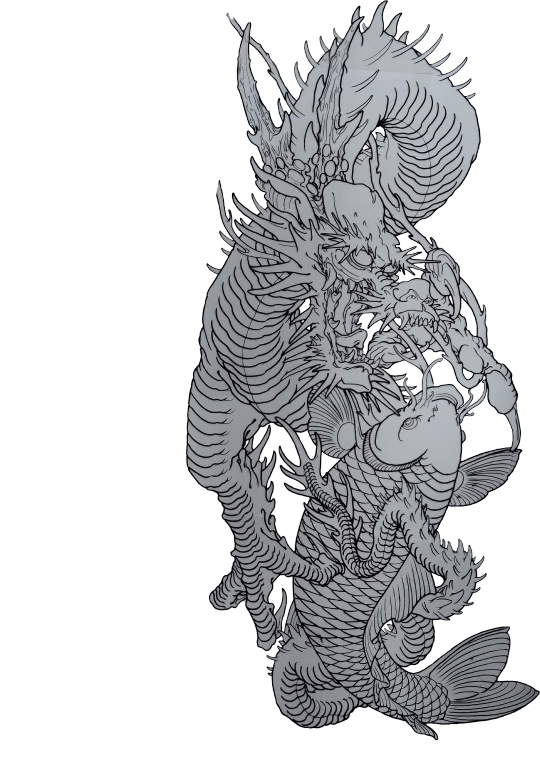
I spent a day outside of work photographing Hamish and a lot of his personal work in order to build up a background on irezumi tattooing and practice
I also wanted to test whether this could be an option of alternate imagery in my publication rather than the straight illustration.
Although I wanted to illustrate. I also tried out photographing other artists and their work for the publication imagery to see if it could be a better fit. These images are of Hamish Mclauchlan, the tattoo artist I work under. He specialises in largescale Irezumi pieces and is widely recognised in the tattooing world.
Ultimately I decided against using an artists face or their professional work in my publication. This is because I wanted the focus to be on the concept of irezumi itself, without attaching a specific person and their established style of tattooing to it.
I used my own illustrations because although they are all produced by one person, they are an ambiguous interpretation of a massive collection of irezumi artwork. The reader should be able to envision their own world of irezumi from the publication without bias.
Typography
I know I want my display type and potentially bodycopy to follow a loose, script like/ handrawn, personable feel. Something inky and imperfect would be excellent for a title font as I want it to match the illustrations in this illustrative and painted style. Below are some rough options that I was drawn towards for the minimal type that I plan to have in this picture book like publication.

Alphabet for Irezumi
Since I want my picture book to follow this ABC structure I started brainstorming ideas for each letter of the alphabet. I thought this would be a way to link the western world to this popular Japanese tattoo style that has been made popular worldwide. Western clients are becoming more and more common and this is likely who my picture book will be aimed towards as they are more likely to have a lack of understanding of the cultural and historical symbolism of the irezumi style rather than local Japanese people.
The only thing to take into consideration is the fact that in japan a few letters in the english alphabet do not exist so I will have to comment on this at some point in my book as some letters such as q and x. Below is my current list that I am constantly returning to in order to structure my illustrative process moving forward.
Ape, Akkorokamui (octopus)
Bones, Baku (devoured of dreams), Blossum, Botan (peony)
Cat, Crab, Crane, Crysanthumum
Daruma
Enkō (kappa of shikoku), enenra (yokai of smoke)
Frog, Fujin, Foo dog
Geisha, Golden boy, Genbu (black tortoise)
Hannya, Hou-oo (pheonix), Hebi (snake), Heikegani (crab)
Irezumi, ikuchi (yokai of the sea, serpent)
Jorogumo (spider woman), Jishin-namazu (giant catfish that causes natural disasters)
Koi, Kitsune, Kappa, Kirin, koinobori, Kiku (Chrysanthemum), Kaeru (frog)
Lotus (Hasu)
Masks, monkey, Maneki Neku (cat)
Nue (chimeria), Namakubi (severed head), Namazu (catfish), Noppera-bō (faceless ghost)
Oni
Pheonix, Peony
Q
Ryu, Raijin
Serpent, Sakura, Samurai
Tiger, Tengu, Toad, Tanuki (raccoon dog)
Ushi-Oni
Vulture
Warrior, Wave of Kanagawa, wakkaonna
X
Yokai (ghosts demons spirits)
Zugaikotsu (Skull)
5 notes
·
View notes
Text

"Coffee Plant".
"Looping Tendrils and Supple Petals Overflow From Lina Kusaite’s Ethereal Botanical Illustrations
June 1, 2023
ThisIsColossal.com
Kate Mothes
All images © Lina Kusaite, shared with permission
“I love spending hours in the art shop, feeling the surfaces of different paper and making connections with all information that I carry with me about the project,” says Lina Kusaite, whose meticulous botanical illustrations range from book pages to expansive wall murals. Mostly focusing on commissions for clients like publishers and hospitality venues, the Brussels-based artist has a knack for collaborating with other designers to determine the scale and scope of an installation or a series of drawings. “I always choose projects that speak to me (and) in one or other way resonate with my point of view, philosophy, and it challenges me,” she says.
Kusaite begins by hand-drawing on paper, focusing on the lines and textures of different materials like graphite and ink. “I choose paper and pencil or watercolors—or both—based on the research and information gathered in the beginning of the process,” she says. “I start testing different combination, colors, lines. After having enough tests on paper, I scan everything and transfer it into Photoshop, where I start playing with digital tools.” Sometimes, one initial drawing can produce hundreds of versions resulting from experiments with color and style, which often spawn new ideas and techniques for future projects".
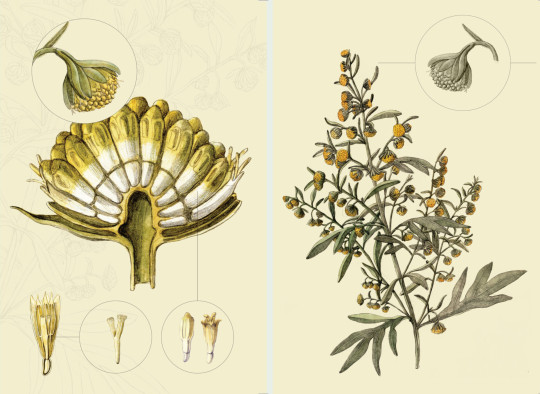
"Artemesia absinthium".

"Rosemarin"
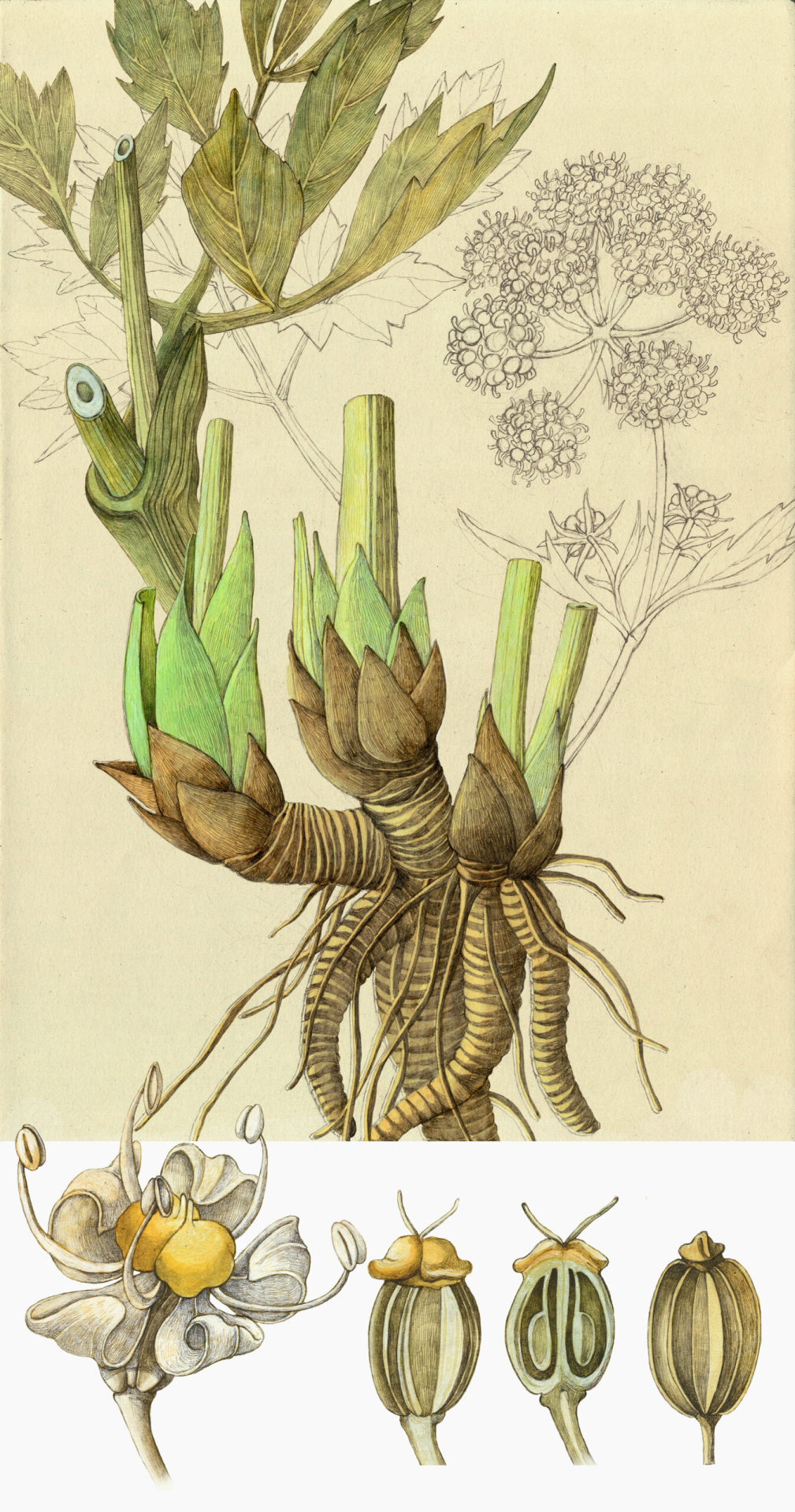
"Lavas Plant".

"Artemisia Plant".
0 notes
Text
sociieties asked: kazuya, completely exhausted, all but throws himself onto the floor of ryou's room. " tell me everything about whatever you're into now, i don't want to think anymore. "
ryou's working on a sewing project - something to take his mind off of art for a moment, when kazuya all but enters into his room, and tosses himself down on the floor and speaks into it. he gives permission for ryou to ramble, and so, ramble, ryou does. ( his best friend looks tired / exhausted, and if this is how he can help then, it is how he will help. ryou is good at talking and rambling. )
" so watercolor painting started around 4,000 BC, back during paleolithic europe. It was used for manuscript illustrations since egyptian times, and in the european middle ages, there was a particular prominence. some say that watercolor painting, developed in cave paintings of paleolithic europe. that, however, that means that it's an ancient form of painting - if not the most ancient form of art itself. the continuous history of watercolor as an art medium however begins with the renaissance, particularly, the german northern renaissance and they even had a school of watercolor painting. " he stands as he moves to his paints, and points out his watercolors and watercolor paper, " watercolors were generally used by baroque easel painters - but only for sketches, copies or cartoons. botanical illustrations and wildlife illustrations are probably the oldest forms and most important traditions in watercolor painting - even today, that's usually their primary use. watercolor however, was less popular in continental europe, where they preferred to use gouache, instead. " he pauses, " gouache is an opaque watercolor, basically. " a short history on what watercolor painting is, before he goes into his newest wants and needs. he breathes, and moves to a different area where he gestures at the tools that he had gotten recently.
" i've been getting into making my own watercolor paints lately. they consist of a pigment, gum arabic as a binder to hold the pigment in suspension, and additives and preservations, and evaporating water, a solvent used to thin or dilute the pain. so to make your own, you need to grind down the gum arabic - which comes in hard, brittle lumps. you have to grind it down in a pestle and mortar until it becomes a powder. then, you dissolve one part gum arabic powder in three parts boiling water, and pour slow and stir for 10 to 15 minutes. once that's done, then you pour the mixture through a muslin cloth. this gets rid of any bits of bark and other impurities. add some honey or whatever additive / preservative you're planning on use. it makes the paint more fluid and easier to work with. usually you need four parts solution to one part honey. then you mix in pigment. i - personally, have been using old make up eyeshadows that are out of date. crush it up real nice, then you mix the two together, and grind on a griding slab. then you put them into pans or half pans, and leave them to sit. "
1 note
·
View note
Text
The Uncanny Failures of A.I. — Generated Hands
When it comes to one of humanity’s most important features, machines can grasp small patterns but not the unifying whole.
— By Kyle Chayka | March 10, 2023
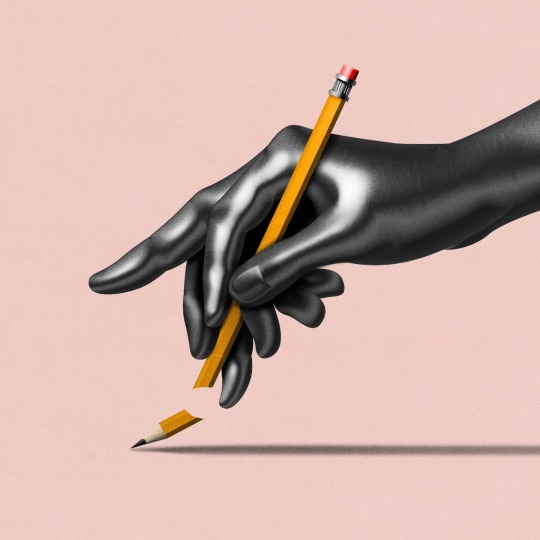
Illustration By Nicholas Konrad/The New Yorker
It’s a classic exercise in high-school art class: a student sits at her desk, charcoal pencil held in one hand, poised over a sheet of paper, while the other hand lies outstretched in front of her, palm up, fingers relaxed so that they curve inward. Then she uses one hand to draw the other. It’s a beginner’s assignment, but the task of depicting hands convincingly is one of the most notorious challenges in figurative art. I remember it being incredibly frustrating—getting the angles and proportion of each finger right, determining how the thumb connects to the palm, showing one finger overlapping another just so. Too often, I would end up with a bizarrely long pinky, or a thumb jutting out at an impossible angle like a broken bone. “That’s how students start learning how to draw: learning to look closely,” Kristi Soucie, my high-school art teacher, in Connecticut, told me when I called her up recently. “Everyone assumes they know what a hand looks like, but until you really do look at it you don’t understand.”
Artificial intelligence is facing a similar problem. Newly accessible tools such as Midjourney, Stable Diffusion, and dall-e are able to render a photorealistic landscape, copy a celebrity’s face, remix an image in any artist’s style, and seamlessly replace image backgrounds. Last September, an A.I.-generated image won first prize for digital art at the Colorado State Fair. But when confronted with a request to draw hands the tools have spat out a range of nightmarish appendages: hands with a dozen fingers, hands with two thumbs, hands with more hands sprouting from them like some botanical mutant. The fingers have either too many joints or none at all. They look like diagrams in a medical textbook from an alien world. The machines’ ineptitude at this particular task has become a running joke about the shortcomings of A.I. As one person put it on Twitter, “Never ask a woman her age or an AI model why they’re hiding their hands.”
As others have reported, the hand problem has to do, in part, with the generators’ ability to extrapolate information from the vast data sets of images they have been trained on. When a user types a text prompt into a generator, it draws on countless related images and replicates the patterns it has learned. But, like an archaeologist trying to translate Egyptian hieroglyphs from the Rosetta Stone, the machine can deduce only from its given material, and there are gaps in its knowledge, particularly when it comes to understanding complex organic shapes holistically. Flawed or incomplete data sets produce flawed outputs. As the linguist Noam Chomsky and his co-authors argued recently in a recent Times Op-Ed, machines and humans learn differently. “The human mind is not, like ChatGPT and its ilk, a lumbering statistical engine for pattern matching, gorging on hundreds of terabytes of data,” they wrote. Instead, it “operates with small amounts of information; it seeks not to infer brute correlations among data points but to create explanations.”
A generator can compute that hands have fingers, but it’s harder to train it to know that there should be only five, or that the digits have more or less set lengths in relation to one another. After all, hands look very different from different angles. Looking down at my own pair as I type this on my laptop keyboard, my fingers are foreshortened and half obscured by my palms; an observer wouldn’t be able to determine their exact X-ray structure from a static image. Peter Bentley, a professor of computer science at University College London, told me that A.I. tools “have learned that hands have elements such as fingers, nails, palms. But they have no understanding of what a hand really is.” The same problem sometimes occurs when A.I. tries to render smaller features such as ears, which appear as fleshy whirlpools without the intricate cartilage structure; or teeth, which sit incorrectly in the mouth; or pupils, which turn out as caprine blobs. A.I. can grasp visual patterns but not the underlying biological logic.
Part of the problem is that most images of people don’t focus on their hands. We’re not awash in closeups of fingers the way we are in pictures of faces. “If the data set was one hundred per cent hands, I think it would do much better, as the model would allocate more of its capacity to hands,” Alex Champandard, the co-founder of a company called Creative.ai, which develops tools for creative industries, told me. One solution may be to train A.I. programs on specialized monographic data sets. (At his company, Champandard is currently building training sets made up entirely of asphalt or brick images so that filmmakers or video-game developers can quickly add surface texture.) Another might be to add three-dimensional renderings to A.I. data sets, Bentley told me. There is currently no 3-D equivalent of a well-tagged Getty Images archive that an A.I. tool can be trained on, but last December the Microsoft-supported startup OpenAI published a paper teasing a tool that creates three-dimensional models, which could help give image generators more spatial awareness—a knowledge of the skeletal structure beneath 2-D skin.
When writing prompts for A.I. generators, users often aren’t very exact. They might enter the word “hand” without specifying what said hand should be doing or how it should be posed. Jim Nightingale, a former copywriter living in New Zealand who has become an A.I. consultant, told me that he advises people to “imagine how the training images might’ve been labelled, and reverse engineer your prompt from there.” Nightingale suggested naming “recognizable gestures,” such as a clenched fist, and traits, such as hairy knuckles, to help generators isolate more specific or detailed source imagery. Such tricks don’t always work, however. One client of Nightingale’s was an author who needed a digital book cover. The A.I. generated a convincing human figure but had trouble producing a specific hand gesture that the author had in mind, so Nightingale brought on a freelance human artist to paint them into the A.I. image manually.
At least thus far in generative A.I.’s life span, users tend to seek images that get as close to reality as possible. We judge A.I. based on how precisely it replicates what we’ve already seen. Looking at gnarled A.I. hands, we fall into the uncanny valley and experience a visceral sense of disgust. The hands are both real—textured, wrinkled, spotted, with more detail than most human artists could achieve—and totally at odds with the way hands are supposed to be. The machine’s failure is comforting, in a way. Hands are a symbol of humanity, “a direct correspondence between imagination and execution,” as Patti Smith recently wrote. As long as we are the only ones who understand them, perhaps our computers won’t wholly supplant us. The strange contortions of A.I. hands make me feel a sense of anticipatory nostalgia, for a future when the technology inevitably improves and we will look back on such flaws as a kitschy relic of the “early A.I.” era, the way grainy digital-camera photos are redolent of the two-thousands.
Over time, we’ll have fewer clues about which images were generated by A.I and which were made by human hands. As Champandard told me, of the proliferation of odd fingers and incomplete claws, “I think this is a temporary problem.” Soucie, my art teacher, pinpointed a similar novice’s problem in the A.I. images and in her pupils’ drawings. “A student who’s in eighth or ninth grade, when they draw their hand, they always concentrate on the contour,” she said. A young artist tracking the wiggly line of wrinkled skin gets distracted from thinking about the hand’s over-all form, its three-dimensional quality. Like any struggling art student, A.I. tools will benefit from more training. “There’s a point when the structure and the contour come together for a student,” Soucie said. “That’s usually, like, the second year of college.” ♦
0 notes
Text
Interview with Artist & Illustrator Yulong Lli
New Post has been published on https://china-underground.com/2020/11/26/interview-with-artist-illustrator-yulong-lli/
Interview with Artist & Illustrator Yulong Lli
Inspiring Shanghai Illustrator Yulong Lli turning draw and illustration artwork into a moment of joy and possibilities
Yulong Lli is a Shanghai-based freelance illustrator who studied at the China Academy of Art and is represented by Richard Solomon in New York. In his drawings and illustrations, he seeks and explores new ways to tell stories through different colors and creating compositions, where his creative style remarks the fusion of eastern and western culture. The inspiration for his graphic design also comes from vintage posters and modernism. He has an impressive list of well-known clients: Apple, Airbnb, Google, Uber, Ikea, LVMH, Gucci, Cartier, Pernod Ricard, Starbucks, Vogue, GQ magazine, Esquire, Cosmopolitan, New York Times, ELLE Decoration, Johnson & Johnson, Bloomberg Businessweek, Men’s Health, Hong Kong Airlines, Modern Weekly magazine, LVMH, etc … These are just some of the many brands that Yulong Lli has worked with. He has received many international awards, including Hiii Illustration 2016 best of best, 3X3 illustration annual, Communication Arts Illustration annual, and ADA’s Genius Award.
Official Site | Behance | Instagram
How did your adventure in the illustration world begin? What motivated you to become an illustrator?
I majored in animation during college time, and l realized that I prefer illustration to 3D after trying different intern jobs. At the same time, I never give up on updating my daily sketches and share them on social media casually, which brings some chance to grow up as a professional illustrator, especially my first international client, Airbnb.
Who influenced you as a person and as an illustrator?
When l get started with my illustration career, I’m always in Lisk Feng’s shadows. From her works, I realized there are so many possibilities of illustration, which I never saw. However, to become a professional illustrator I need to organize my visual language representing my unique personal tastes and aesthetics, so it’s hard for me to point out an illustrator who influenced me now. I use to discover something that fascinates me now, like music or movie, which is not just about illustration.
His illustrations convey a real optimism, as they have a positive outlook towards the future but with full awareness of the present
Chinese New Year reunion dinner cover © Yulong Lli
Do you remember your earliest drawing? What was it about?
It’s the Sailor Moon, a Japanese comic and animation character. I asked my father to buy me a picture book of her and copied one with Chinese painting.
Yulong Lli’s illustration artwork is well balanced and designed to make you think.
Cards Against Corona © Yulong Lli
What illustration impressed you the most in your childhood? What are your best memories?
Chinese picture storybooks impressed me a lot when l was a child. It’s an old-fashioned way to tell traditional Chinese stories by images with fewer words. As well known, most of the children don’t like to read a book full of words, so that’s my best joyful experience of study.
The Royal Botanical Garden, Edinburgh © Yulong Lli
What are your sources of inspiration? What are some of your favorite subjects to draw, and what is the creative process behind your artwork?
My inspiration always comes from my daily life, but l also collects a database of my favorite artworks just in case, like contemporary arts, photography, vintage posters, etc.
When I get a new assignment, I think about the key points behind the story first. After research and paper doodling, I will sketch and make color palette based on my mind’s direction. Lastly, I add details inside and finish everything.
Shanghairen, cover © Yulong Lli
What better focus your personality, in your creations? Does the color palette you use reflect the way you see the world?
I think that color palettes and constructions reflect my personality very well. Still, I also try different ways to hire what l love into my works as surprise, like my favorite but unaffordable furniture or fashion style. LOL!
My friends always joke with me about my color taste, saying they come from a person who falls in lovemaking him feels cheerful. I’m willing to hear that because that’s exactly what l want to deliver through my work.
My love moment © Yulong Lli
What do you like most about your job, and what are the greatest satisfactions?
It’s a very simple, painting. I choose illustration because it’s a comfortable way for me to express myself, and images are very straight forward to build a bridge between me and spectators. Visual communication with them makes me feel satisfied as l know we find some common feelings from my works.
His illustration works also deal with themes of diversity and inclusion using vibrant, and joyful colors.
Love is everything © Yulong Lli
What is the biggest challenging when you have to start a new project?
The biggest challenging l have to face is a deadline, using the limited time to present a good idea with what I have, especially for editorial works as they always come and go in a hurry. Besides, I’m not sure whether the topic is familiar for me or not, but I’m enjoying it.
Yulong Lli’s design is fresh, sparkling, vital, and energetic and reflects his way of seeing the world.
Liquidity Self identification © Yulong Lli
Are there any of your illustrations related to a moment that marked a significant point in your life? Could you share with us the story behind it?
I was invited to create a cover illustration for a fictitious magazine named the Shanghairen last year, inspired by the New Yorker magazine. At that time, I exchanged to the UK, stood outside of my familiar environment, so I have an opportunity to describe my feelings of shanghai as a new resident after living for about seven years, focusing on the resident’s daily life.
Working on commercials projects allow him to communicate different ideas or emotions to a specific target, learn to solve different problems, and move over the limits of communication.
Invisible Domination © Yulong Lli
Since you are a Shanghai-based illustrator. Can you tell us how the city has changed in the last year due to the Pandemic situation? Does this period has affected your way of creating and work?
I went back to my hometown and stayed at home for about half a year, so when l came back to Shanghai, the situation has been under control. Therefore, what l saw is a typical metropolis city, but people is used to wearing a mask on the street.
During this time, I accept some commissioned works related to Coronavirus, including a public donation campaign to WHO. It’s good to do something to support and record as a creator.
Girls-power 2 © Yulong Lli
Girls-power 1 © Yulong Lli
Cover for L&L © Yulong Lli
Images courtesy of Yulong Lli
#Illustrator
0 notes
Text
Today was so hot
We went to the mall to try a new burger place. The junkporium near the burger place had dozens and dozens of Disney pins. I couldn't really find any Lilo and Stitch pins, but the pins were three for twenty bucks, so when I found a Mike and Sulley pair, I decided that I could grab a Lilo popsicle. They had one of my dream tarot decks, but we decided to pass it up for now because the pins were supposed to be a little more than I ended up paying. I will have it...... eventually.
So since our area has lifted most pandemic restrictions and then also we've transitioned out of winter, and our city has winter routes and schedules and they're different for summer, anyway, we ended up getting a little turned around, so while we were waiting for another bus, I started pondering things like making my own digital washi tapes and stickers for this idea I had.
I know the point of junk journaling is that it's usually tactile and a little unpredictable, uneven pages, pockets and tags and odds--but that also means it's expensive, because I would have to acquire whatever it is that I want to use in the course of the project--even if I make like decorative papers on purpose and get them either custom printed or just print them myself--like for some reason, I'm fixated on the idea of tarot cards and botanical illustrations. I'm not quite sure this is at all the right vibe for what's meant to be more of a psychological...........hmmmm, idk not a thriller, and not really a horror........ Maybe like, psychological...... self-discovery? It's meant to be a dark story. Anyway, even if I made all of my own stickers and papers and washi tape or whatever else, if I printed everything and assembled it, that would end up being a one of a kind or extremely limited edition art book. And if I just released it as a print-on-demand, I couldn't use things like pockets and tags, because everything would just print flatly on the page.
Hmmmmmm...........
Then there's the issue that my style is not presently very realistic. I'm not sure I'm trying to work toward a more realistic style? I know that I want the characters to feel a little more lively and make the art feel like I care enough without caring too much.
On the other hand, I could just create a ton of like, ground pages using like, I was thinking moth wings, maybe old leaves, definitely botanical illustrations, maybe even text from Alice in Wonderland, possibly illustrations. And I was thinking about adding journal pages--more of a mixed media situation than my current graphic novel.
Anyway, I was just thinking, since I want this project to be more layered than my current graphic novel, whether my resources are digital or physical, whether I create all of my resources from scratch, or only some of them, or maybe I scrounge all my resources from the annals of common use, most of my current graphic novel is figured out, I just need to actually put pencil and micron to paper.......... My next project could bear some consideration so I have a next to feed people by the time I'm done with the current one.
Just......... where to store my ground papers or any other resources......... I honestly have no real idea how long this current graphic novel is going to take.........
Overall, I really want to take this other story more of a Tim Burton, like I said earlier, psychological, style/direction. So I guess I'm not sure how a more realistic/photographic art style fits the story design/idea that I have.....but it does fit the junk journal style......
I have a lot of work to do to lay the groundwork for this one. Beginning by gathering materials.......whooooooo boy........
0 notes
Text
Get Your Hands Dirty with These Farming Books

If you Google "organic farming books" or "top farm books," you're likely to develop a slew of children's books with charming illustrations of men in overalls and straw hats talking about raising cows or driving tractors.
However, there are many farm books available for adults who want to learn more about food and agriculture and how the decisions our farmers make today will affect the world. These fantastic farm books delve into history and science, feature forward-thinking farmers, or spin captivating fiction while teaching readers and providing a diversity of viewpoints on how agriculture has evolved in the modern period.
Please continue reading to know more….
We Are What We Eat: A Slow Food Manifesto
Alice Waters, a longstanding supporter of the Slow Food Movement, examines how food shapes our identities. Waters' latest book examines how food has harmed people and the environment and how it may help heal and restore. "How we eat is how we live," she writes in the book's introduction.
Waters covers America's different food eras, from World War II victory gardens to frozen dinners and fast food, more contemporary farm-to-table efforts, and the virtues of biodiversity and sustainability through her own lived experiences. Above all, the book is a contemplation on how what we eat affects not just ourselves but also the planet and what may be done to effect long-term change.
What's Good? A Memoir in Twelve Ingredients
Chef Peter Hoffman, whose New York City's Savoy restaurant helped pioneer farm-to-table cooking, delves into our foods' cultural, historical, and botanical origins. The book is based on his excursions to Union Square Greenmarket.
He begins his ingredient tour and story with leeks and potatoes, travels through strawberry and garlic season, and finishes with late-season greens like kale and radicchio. He tells personal anecdotes about these crops and chronicles their evolution and the experiences of the farmers and vendors who raise and promote them. Hoffman provides a recipe for home cooks to make with each component at the end of each chapter.
The Economics of Sustainable Food
This book examines why economists and policymakers overlook the negative consequences of the global industrial food system, such as starvation, economic losses, and environmental destruction. Nicoletta Batini, the editor, claims that macroeconomic policy has mainly ignored food systems, and she has gathered a collection of essays that offer suggestions for making food more sustainable.
For example, various authors look into taxing high-carbon-footprint foods, supporting land and sea farming, and providing schools with matching cash to buy local organic vegetables.
The Heirloom Gardener: Traditional Plants & Skills for the Modern World
John Forti, historical horticulture and ethnobotanist, honours the value of gardens in the past, present, and future. The Traditional Gardener is a part essay collection. This half gardening guide encourages readers to embrace heirloom seeds and traditions while also acting as a timely reminder to slow down and reconnect with nature.
Organic Gardening for Beginners: An Eco-Friendly Guide to Growing Vegetables, Fruits, and Herbs
Want to build an organic garden at home but not know where to begin? This book is an excellent starting point. Lisa Lombardo, a homesteader, teaches how to grow dozens of fruits, veggies, and herbs in sustainable, pesticide-free, and environmentally friendly ways. She also provides a helpful breakdown of the most common insects you'll encounter—both good and bad—and practical advice on assisting the beneficial insects in growing and safely ridding your garden of pests.
Toxic Legacy: How the Weedkiller Glyphosate Is Destroying Our Health and the Environment
Stephanie Seneff, an MIT scientist, warns about the hazards of the herbicide glyphosate. Glyphosate, the main ingredient in Roundup, was first patented in 1961 and then re-patented as a weed killer by Monsanto in 1968.
Seneff discusses glyphosate's use in agriculture and references studies linking the chemical to cancer, kidney failure, birth deformities, infertility, and other ailments. Rachel Carson's Silent Spring, which revealed the environmental repercussions of pesticide use, has been likened to the novel.
Urban Farmers: The Now (and how) of Growing Food in the City
According to some projections, cities will eat 80 per cent of all food by 2050. As a result, future generations will rely heavily on urban farmers to feed them.
Photographer Valery Rizzo and journalist Mónica R. Goya present a wide range of urban agriculture models in this book, including rooftop gardens and vineyards, community gardens, and underground mushroom farms. It also provides helpful hints for those interested in urban gardening, beekeeping, composting, natural dyes, and other topics.
Article Source: https://greenerbooks.co.uk/blog/post/get-your-hands-dirty-with-these-farming-books
0 notes
Photo
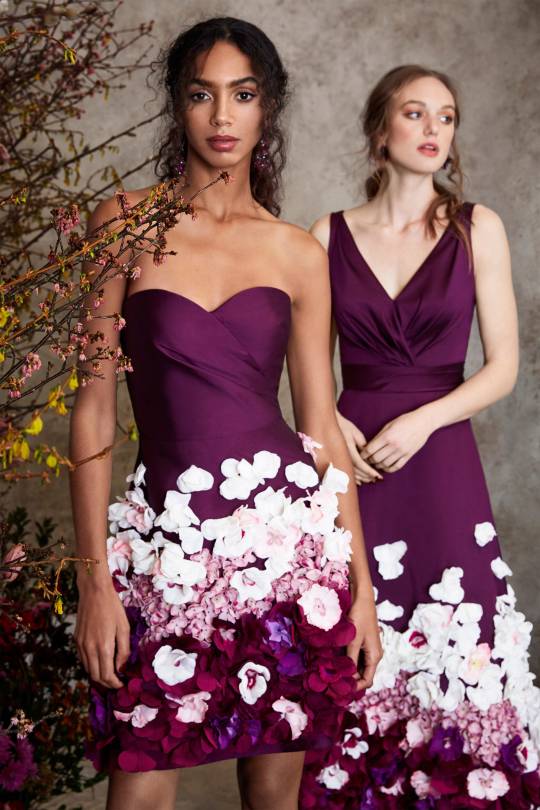
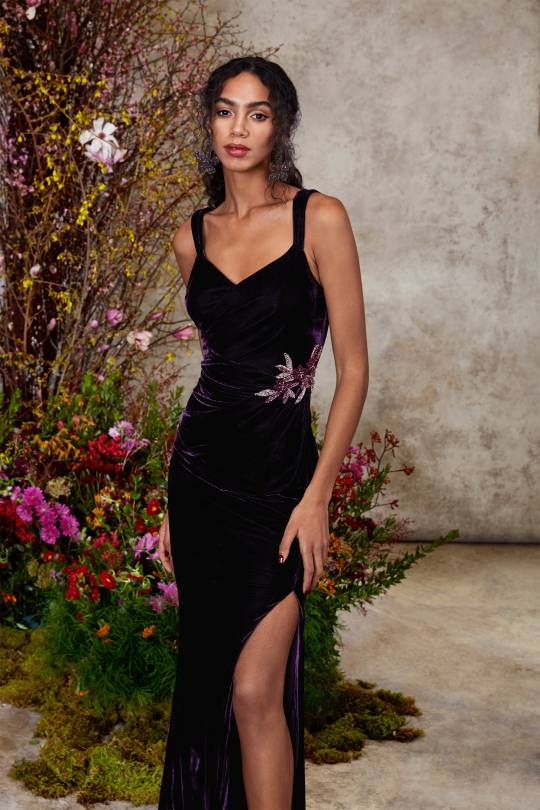


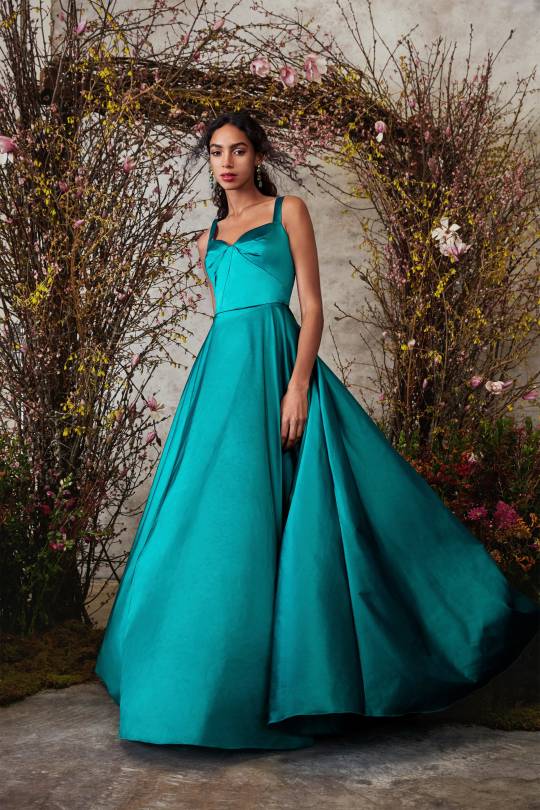

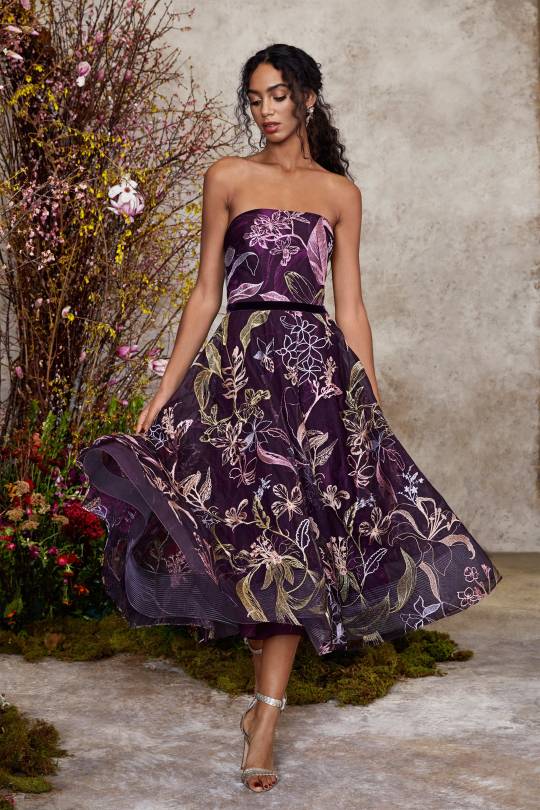
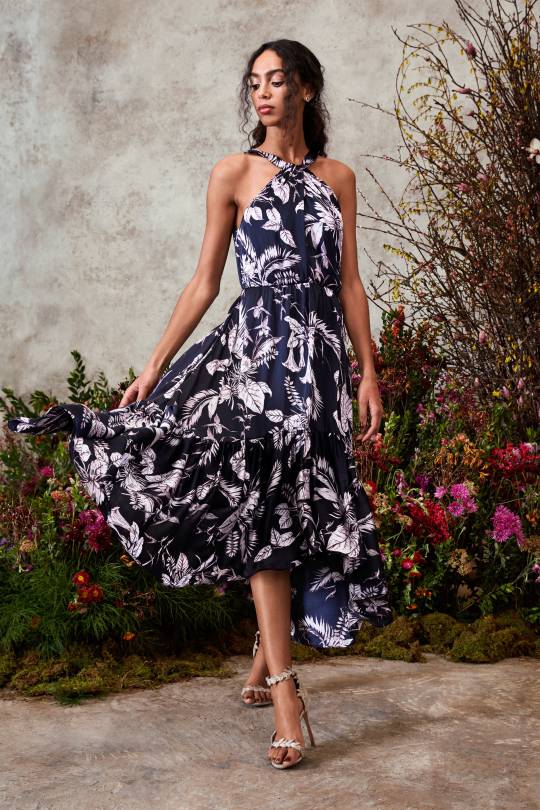

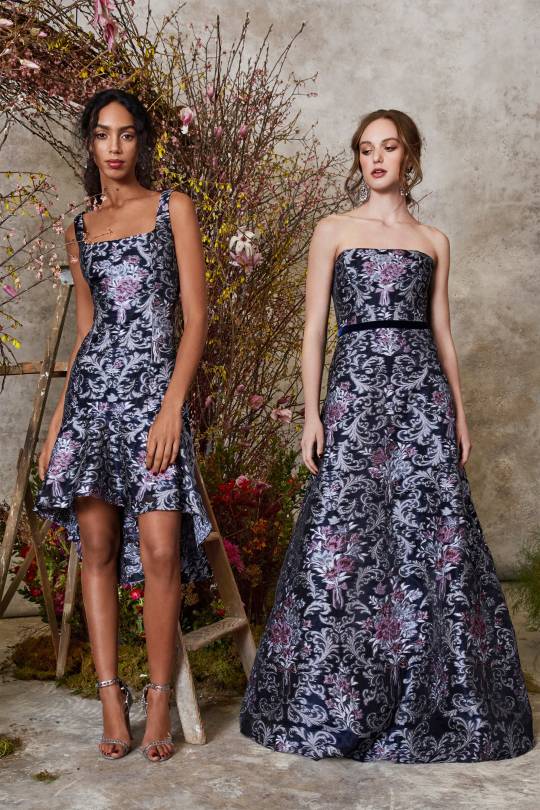
Marchesa Notte Fall 2020 Ready-to-Wear
Photos courtesy of Marchesa Notte
#fashion#marchesa notte#fall 2020#ready-to-wear#scopophobia /#favorite#their starting point was the botanical illustrations of#margaret mee#thewonderofliving
21 notes
·
View notes
Photo
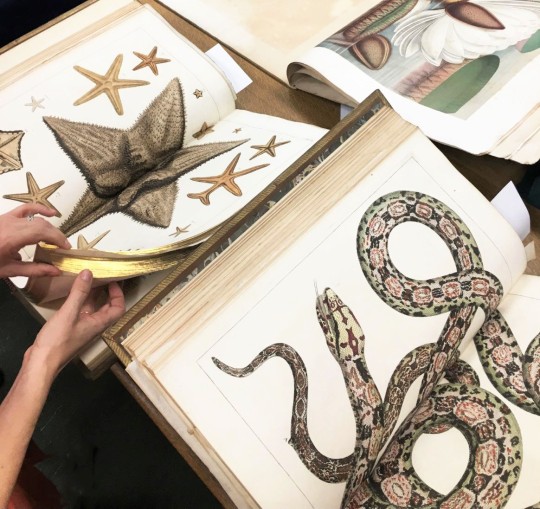

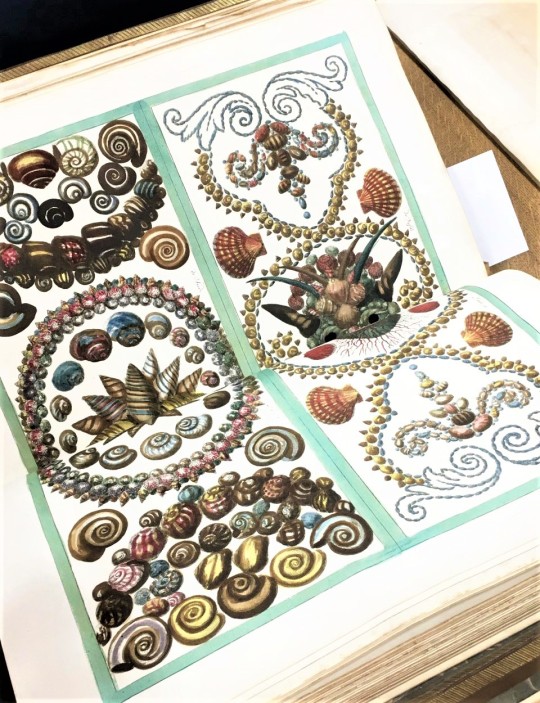



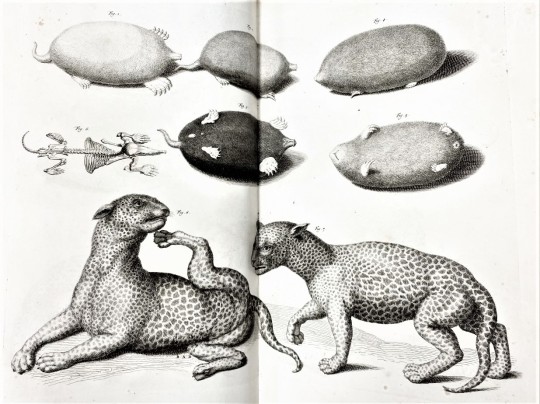


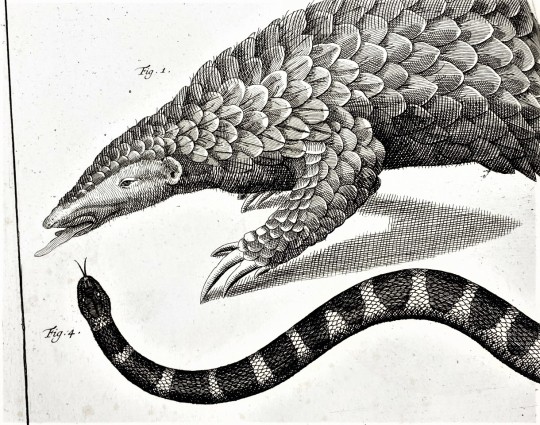
The Spectacle of Nature: Albertus Seba’s Cabinet of Curiosities
The act of collecting is inextricably linked to the practice of natural history in the West. Beginning in the 16th century, collections of natural specimens became known as a cabinet of curiosities. These collections were often encyclopedic in their scope, attempting to form a universal cabinet with all known natural objects. One of the most famous of these cabinets was that of Dutch apothecary Albertus Seba (1665-1736) who was based in Amsterdam and spent decades compiling unique specimens from the far reaches of the globe. Pharmacists, apothecaries, and those working in medicine were practitioners of natural history because historically medical remedies were mixed together from substances found in in plants, animals, and minerals.
Albertus Seba was financially well off and living in a prime location to compile an extensive collection of natural curios. As we mentioned last week in our post on Maria Sibylla Merian, Amsterdam was the center of maritime trade during the Dutch Golden Age roughly spanning 1588-1672. During this time specimens poured in from the East and West Indies. Seba commissioned artists to make illustrations of his extensive collection which were published in his book Locupletissimi rerum naturalium thesauri (often shortened to Thesaurus) published in four volumes from 1734-1765 in Amsterdam by J. Wetsten, William Smith, and Jansson-Waesberg. The books contain 446 copperplate illustrations. The portrait of Albertus Seba was executed by the engraver Jakob Houbraken (1698-1780) after a painting by Jan Maurits Quinkhard (1688-1772). It depicts Seba with his cabinet; behind him are glass jars which is reminiscent of the 15th century book Ortus sanitatis, or “Garden of Health.” An interesting aspect of Seba’s portrait is that it depicts him pointing to a book containing natural history illustrations.
Seba’s Thesaurus truly lives up the title of our “Spectacle of Nature” series because the natural objects are displayed in a wondrous way. Seba’s books inspired other naturalists such as Carl Linnaeus to start thinking of the natural world as a system that could be ordered. Albertus Seba’s cabinet was purchased by Peter the Great in 1717.
We do not have a copy of Seba’s Thesaurus in UW-Milwaukee Special Collections. These images are from UW-Madison Special Collections’ uncolored copy. The colored version is from the Huntington Library, Art Museum, and Botanical Gardens, which I saw in 2019 during a California Rare Book School class.
There is a digitized colored copy of Seba’s Thesaurus available through the Biodiversity Heritage Library.
There is also a wonderful, life-sized reproduction by Taschen in the UW-System’s circulating collection: Cabinet of Natural Curiosities: locupletissimi rerum naturalium thesauri 1734-1765: based on the copy in the Koninklijke Bibliotheek, The Hague.
View more posts in the “Spectacle of Nature” series.
–Sarah, Special Collections Senior Graduate Intern
#The Spectacle of Nature#Science Saturday#Albertus Seba#Cabinet of Curiosities#curiosities#curios#history of science#Locupletissimi rerum naturalium thesauri#UW-Madison Special Collections#Thesaurus#scientific illustration#natural history#natural history illustration#Dutch#Huntington Library Art Museum and Botanical Gardens#Jan Maurits Quinkhard#Jakob Houbraken#18th century#copperplate engravings#hand colored plates#nature#animals#snakes#bats#shells#Sarah Finn#sarah
243 notes
·
View notes
Text
Mid-sem Break: Illustrative Process
I spent a large amount of time producing the various illustrations for the publication so I can focus on publication design and format in the coming weeks. Here is my current progress.

B is for Botan (peony)
Peonies are one of the most common flowers found in traditional Japanese tattoos, but that doesn’t mean they’re not special. The Peony Rose is seen in China and Japan as the ‘King of Flowers’.
When considering a peony tattoo design, you may come across some common pairings with other irezumi creatures (symbols). That’s no coincidence, the symbolism of one powerful tattoo motif often shifts when paired with another. In the case of a peony, you can make the intention behind your tattoo clearer by including other images in your tattoo design. For instance, when paired with a dragon, the dragon and the peony tattoo play off of each other, representing both brute strength and a softer, more intellectual sense of courageousness.
What does a Botan tattoo mean?
In short it means elegance and wealth. It is regarded as a symbol of wealth, good fortune and prosperity. The peony is a strong symbol of beauty, fragility and transitory nature of existence. Furthermore, they depict that getting great rewards is only possible by taking great risks.
Key words
Wealth
Prosperity
Elegance
Nobility
Healing
What do they look like?
With it's large and spreading petals, which are delicately curled at the edges, the peony has been called “the rose without thorns”. Although often depicted in tattoo imagery in deep red, it is today also cultivated in many other colours. Their natural form, with blooms up to six inches, lush lobed petals, and wide range of colors,translates perfectly into body art.
Reference Images for illustration

Illustrative Process and Final Result
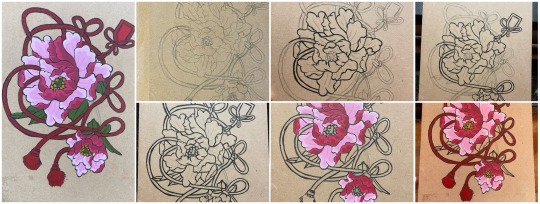
Information and Meaning Links
https://www.irezumiart.co.uk/irezumi-symbology/
https://www.tattoodo.com/articles/the-imperial-peony-traditional-japanese-tattoos-of-botan-13402
https://www.bkktattoostudio13.com/japanese-tattoo-flowers-meaning.html

F is for Frog
The Japanese see many positive symbols of frogs, as they appear in large numbers when it rains. These same rains mark the start of farming seasons. This has led to the frog becoming a symbol of rain, fertility, and wealth, and is supposed to attract and protect wealth in homes and businesses.
What does an Frog tattoo mean?
The word “Kaeru” or frog in Japanese means return, which is why the frog is considered a lucky animal in Japan. There is good fortune in things returning. They are linked to things or people returning to a place or origin. They are lucky to keep around so that money, friends and other things that you usually see off or give away will at some point come back. They are believed to be companions of safety in travel as they bring people home safely. They are a sign of spring and therefore youth.
Key words
Protector
Abundance
Success
Harvest
What do they look like?
Frogs are common subjects in Japanese culture and Irezumi. They are seen alone or holding things such as leaves, instruments, tools, food or other household items. They are also often dressed as samurai, weapons and all.
Reference Images for illustration

Illustrative Process and Final Result
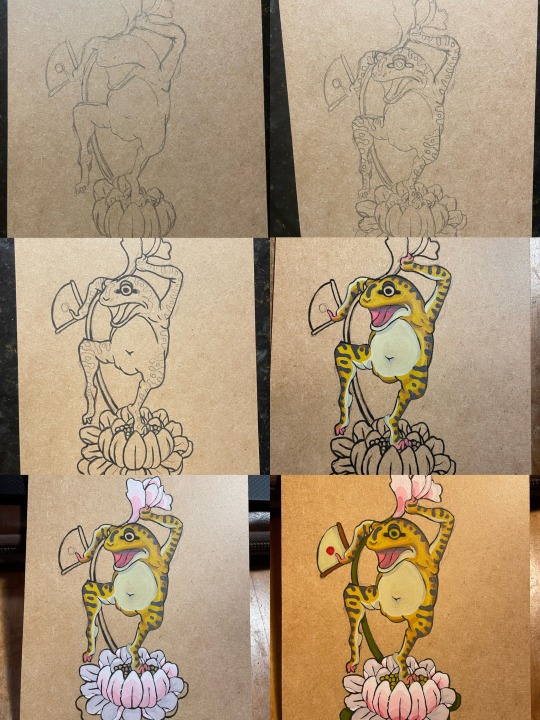
Information and Meaning Links
https://allthingstattoo.ca/2017/12/15/japanese-frog-tattoos/
https://www.bodytattooart.com/japanese-frog-tattoo/
https://www.thejapaneseshop.co.uk/blog/japanese-symbolic-animals-meanings/

M is for Mask
Mask tattoos depict a mask or face, usually emphasizing or portraying a strong emotion. The design is often deeply emotional and symbolic to those who wear it. Japan has a variety of mask designs stemming from theatrical, supernatural, and historical references. Since there are such a selection of different irezumi masks with different meanings, I will provide only one specific example for my publication. A common mask symbol in irezumi culture is that of the tengu mask.
Tengu, in Japanese folklore, a type of mischievous supernatural being, sometimes considered the reincarnated spirit of one who was proud and arrogant in life. A great choice for the dramatics of mask tattoos in irezumi culture.
What does a Mask tattoo mean?
Tengu masks pay homage to a deity that is part of Japanese mythology whose history is complicated to say the least. Originally a demon, bringer of destruction and instigator of chaos, his evolution led him to become one of the most respected and celebrated Shinto gods.
With many different Tengu characters and myths, as well as entirely different types of Tengu spirits, their meaning and symbolism are quite diverse, often with contradictory representations. These beings have been depicted as evil, morally ambiguous and as benevolent, depending on the myths.
As for the Tengu myths that also described them as morally-ambiguous and mysterious mentors and protective spirits, that’s a common representation of many yokai spirits in Shintoism.
Key words
Protectiveness
Pride
Vanity
Respect
What do they look like?
The most famous image of a tengu is a red face with a long nose, giving it the appearance of a goblin. When most people talk about Tengu yokai today, they usually mean the Diatengu.
Reference Images for illustration

Illustrative Process and Final Result

Information and Meaning Links
https://www.savedtattoo.com/oni-mask-tattoo/
https://www.tofugu.com/japan/tengu/
https://yamatomagazine.home.blog/2019/06/27/how-the-role-of-the-tengu-has-changed-in-japanese-culture/

S is for Samurai
The samurai is an important symbol in Japanese culture. Their Bushido code, (aka “the way of the warrior”) made them role models for discipline, respect, and ethical behaviour in Japan. These warriors shaped the country through both warfare and their conduct.
What does a Samurai tattoo mean?
Samurai is traditionally a male term. As such, featuring them in tattoos is often symbolic of masculinity. That being said, there were some women who trained and fought as samurai.
These stoic warriors were revered for their courage, as well as their skill. Inking one of them on your skin can signify your own courage, or lend you some of theirs. In Japanese culture, honour was an important idea. With their strict loyalty and following of Bushido, samurai are deeply tied to honour.
The samurai is often linked with life and death. This is due to both their militant lives and the Bushido way. They are also famous for their discipline. It allowed them to earn mastery over their bodies, minds, and to hone their skills. A samurai tattoo can represent or inspire discipline in one’s own life.
Key words
Masculinity
Courage
Honour
Discipline
What do they look like?
Your tattoo can show the samurai in a variety of different postures. They can be portrayed with their katana in hand or they can be portrayed on a horse. They may be designed to look fearless or at peace. The vast span of designs offer several different options for you to consider.
Reference Images for illustration
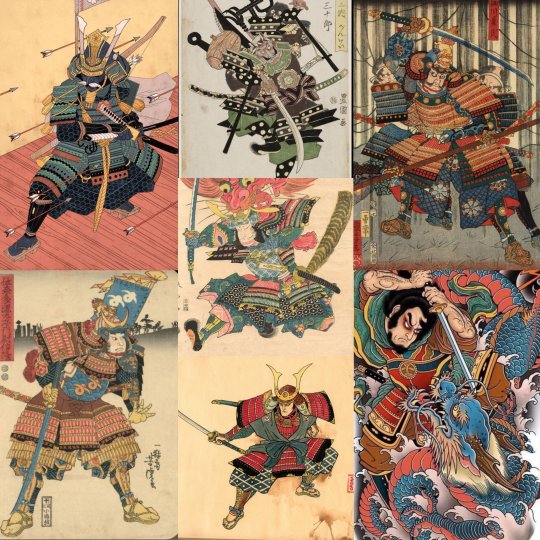
Illustrative Process and Final Result
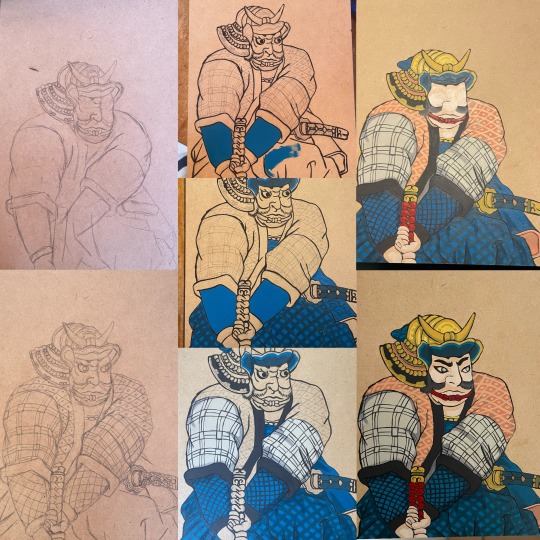
Information and Meaning Links
https://www.britannica.com/topic/samurai
https://japanjunky.com/what-is-irezumi/
https://www.tattooseo.com/samurai-tattoo-meaning/

T is for Tora (Tiger)
Tigers are also said to be able to ward off bad luck, disease and Demons. In many old prints you will see a tiger fighting demons (Oni). Many Japanese artists studied tiger painting and have tried to make their own art even though they have never seen a real one before.
There is not a single tiger in Japan, and no one dared to bring one out of fear and danger. Instead, the Japanese modeled cats as the closest alternative. If you ever wondered why Japanese paintings of tigers are cuter and stiff compared to Chinese paintings of tigers, that is because nobody has seen one before!
Tora has been immortalized in many different ways in Japan. More particularly through irezumi or Japanese style tattoos. Some do it for symbolic reasons, respect for the creature or just personal style.
What does an Tora tattoo mean?
The Tora tattoo has been a symbol for a number of strong emotional meanings. It can symbolize Courage, Ferocity, Passion, Power, Strength or Violence.
The tiger was also associated with the military and samurai because of it’s power. It is a masculine symbol but can be worn by both men and women. Tigers are often seen paired with dragons. In this circumstance, the tiger typically symbolizes the negative attributes such as sickness and misfortune and the dragon symbolizes the positive such as good health, luck and prosperity.
Key words
Strength
Courage
Protector (against bad luck, evil spirits, and disease)
What do they look like?
The tiger is most often seen in tattoos on rocks, surrounded by bamboo with wind and clouds. It can also be paired with other flora to expand the meaning of the design.
There are different variations of the Japanese tiger tattoo and how they are placed on the body. Generally, a longer piece, the Japanese tiger tattoo needs to have room to be tattooed and therefore, prime places would arms, legs back and chest.
Reference Images for illustration

Illustrative Process and Final Result

Information and Meaning Links
https://www.irezumiart.co.uk/irezumi-symbology/
https://www.tattooseo.com/japanese-tiger-tattoo/
https://cyprustattooconvention.com/japanese-tattoos-history-and-meaning/
0 notes
Note
Hi! Could I request Malleus, Azul, Idia, Rook, and Jade headcanons where Yuu — when not with Grim and the ADeuce duo — is oftentimes trailing after/observing them and asking questions about their magic. Because originally, Yuu was a skeptic when it comes to the supernatural/magic from their previous world and always stuck to the scientific explanation of things, and now they can't help but be a curious cat.
Okay, I think I’ve finally (kind of) calmed down from the chapter 6 adrenaline rush (maybe) 💦 To my backlog of writing requests!
Curiouser and Curiouser...

Malleus doesn’t mind your presence--in fact, he seems to welcome it. It’s such a rarity for him to be asked questions, let alone be approached by others in the first place. He doesn’t dislike it at all, so he’ll wave you along, encouraging you to follow in his path.
Malleus has a way of oversimplifying spellcasting. As a magical prodigy, spells that would take a considerable amount of energy and effort for others takes him only a flick of the wrist or the wave of a hand. He’ll pull off some impressive feat, then shrug as though it was nothing while you’re still busy picking your jaw up from the ground.
He likes seeing your shocked looks scale along with the impressiveness of his magic. Disappearing and reappearing behind you grants him a spooked gasp, but when he makes the entire Botanical Garden bloom at once? Your entire face breaks wonderfully. “Fufufu. That’s quite an expression you’re wearing, Child of Man. Let us see if I can wean one able to top that.”
When he has the chance to launch into an explanation, he can talk for hours. Malleus speaks about magic and how it theoretically works, as well as its practical applications, using examples from the Valley of Thorns to illustrate his points. It’s clear from the warmth in his eyes that he has a lot of pride in his abilities, and in his country. If you can’t believe in magic over science... at the very least, you can believe in Malleus’s love for his home.
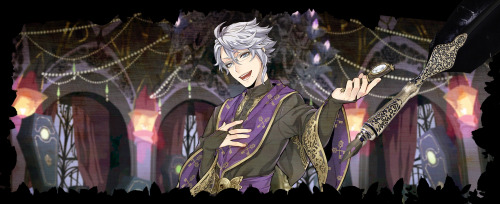
Azul doesn’t mind answering some questions here and there (it leaves you indebted to him, and you never know when he’ll to call on you for a “favor” in return). The way he explains things is quite methodical, likening everything to a business model or some kind of transaction. “Equivalent exchange”, you might call it.
However, Azul really does not appreciate you poking around in his business! How is a merman to do his work (academic assignments, Mostro Lounge management, and sketchy dealings) if you’re hovering over him so often? You’re scaring off both his classmates and his clientele, and that’s not good for business!
Though he doesn’t outwardly express this fear, he worries that you following him around will lead to glimpsing an embarrassing moment that could be used against him! (... After all, that’s basically Jade’s job, so Azul acutely knows how this blackmailing thing works.)
He tactfully pulls you aside for a private audience, suggesting that the two of you hash out a “negotiation” of sorts. Once you’ve sat down, Azul already has a pen and a contract prepared. “If you want to cross a bridge, Ramshackle Prefect-san... or, in this case, receive my tutoring, you’ve got to pay the toll,” he explains. “Take a gulp and take a breath--go ahead and sign the scroll.”
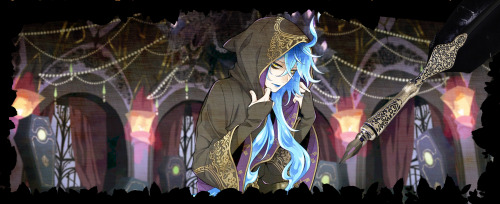
Idia’s unique blend of magic and machinery had your interests piqued since day one... but too bad that he wants nothing to do with you! He finds your questions bothersome, especially when he’d rather be playing a video game or watching an anime than socialize.
Idia keeps trying to shoo you off or shake you off whenever you’re trailing after his tablet! In fact, he has the sound sensitivity on his tablet set to maximum just so the device can pick up your voice and footsteps from a large radius away (and he can get the jump start on distancing himself from you!)
If you happen to be lucky and catch Idia physically attending classes, he’ll pump up the volume on his headphones and pretend as though he doesn’t hear you talking. At some point, he even considers sending Ortho to laser beam you away, but ultimately decides against it since he wants to avoid getting into a lawsuit.
Idia eventually loses his patience and goes on a rant to insult you, “E-Even if I were to explain how magic works to a total noob like you, you wouldn’t even understand it! Why? Cuz I’m a genius and you can’t possibly comprehend how high level and superior my brain and my thinking are!! It’s like the difference between a level 1 NPC villager and the final boss of the last dungeon!!”
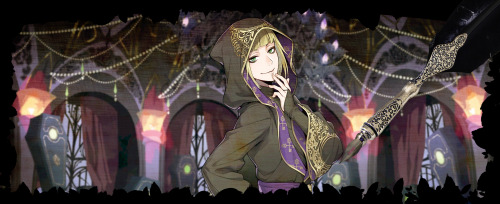
You always lose track of Rook when you decide to tail him. One second he’s there, the next second, he’s right behind you. Your breath goes short when you catch his expression. He has a dangerous look in his eyes, despite his smile, as he regards you.
“Well, now... If it isn’t you, Trickster!” Rook laughs, dispelling the tension in the air. “Forgive me for being on guard--it’s a habit, I’m afraid, of being a huntsman. You should have approached more earnestly if you wished to speak with me, none of this sneaking about business.”
Once you explain your situation, Rook eagerly agrees to assist! He can ramble for quite some time about the intricacies of magic, artfully weaving words together (sometimes in way too much detail, and then he gets sidetracked and meanders from the main idea). The big takeaway from him is that magic is very visual--so long as you can picture it happening, then it can manifest.
You can’t quite bring yourself to believe him, so you press Rook for more information. Instead of a proper answer, he mysteriously taps a finger against his lips and winks. “Not all questions have answers, and not every occurrence has an explanation. Ah--but that is the beauty of life, non? Experiencing, discovering, learning new things... There is nothing quite as beautiful!”

Jade answers your questions politely enough, but the more things you ask of him, the more... passive-aggressive and snarky his responses seem to be. ”... And that is how it functions. It is quite simple, isn’t it? Even a primary school student would be able to tell you this much.”
When you ask if you’re annoying him or wasting his time, he insists that you aren’t. “Amusing myself with the ill-informed and ignorant will never be a waste of my time.” You narrow your eyes at him and ask if he’s low key mocking you, to which he responds with a smile and a reassuring “Yes.”
As for following Jade around and observing his magic in action, well... That’s a whole new can of worms. He’s a very guarded and private person, so he detests people snooping around him even though that’s what he does for Azul. If you start trailing after Jade, you’ll soon find the situation reversed, with the eel chasing you threateningly, magical pen poised to strike you down.
He quickly corners you--and then, the curve of his smile goes from kind to cruel. “Oya. Wherever are you running off to, Prefect-san? I believe you wished to speak with me--so, by all means, please feel free to speak your mind. Those words may just be your very last.” (If magic really does exist, you hope it’s capable of reviving you once Jade’s through with his interrogation.)
#twisted wonderland headcanons#twst#Idia Shroud#Malleus Draconia#Azul Ashengrotto#twisted wonderland#Jade Leech#Rook Hunt#disney twisted wonderland#curiouser and curiouser#Reader#self insert
156 notes
·
View notes